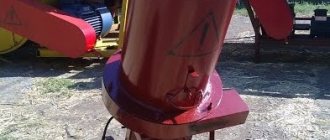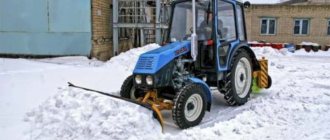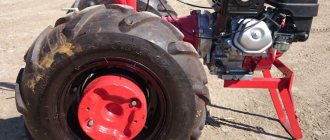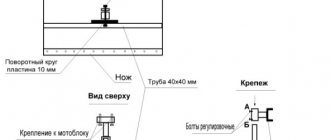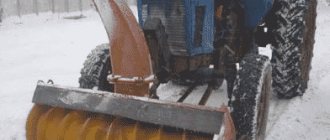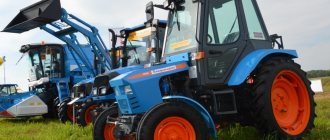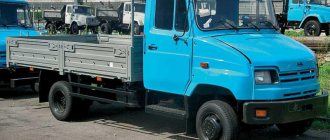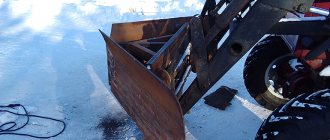SM2-503 SM-2 - Snow removal machine , type - 2 .
Produced from 1965 to 2002 by Transmash. 1899 vehicles were built. A non-self-propelled multi-car snow plow; during cleaning, the removed snow remains inside the gondola cars. Unloading is carried out at designated unloading areas and is driven by an attached locomotive.
Modifications:
- SM-2B - type B with the possibility of coupling the head car with the locomotive (with a minimum curve radius of 200 m)
- SM-2M - Modernized , updated components and assemblies, increased reliability of working elements
SM2A-628
SM2A-635
SM2M-1507
SM2-460 cabin SM2B end car
Snow blower SM-2
The snow train (that's what it's called for short) began production in 1958. The main manufacturing company is Transmash OJSC, located in the city of Engels, Saratov region and created back in 1893. Until 1984, the heavy track machinery plant from Tikhoretsk was also among the manufacturers.
The device consists of four cars, which cannot move on their own - a locomotive is required (which can be contacted via an internal telephone). The first car is the head car; all the equipment for removing snow and chipping ice is located on it. This is where the conveyor begins, transferring the snow mass to the conveyors with which all cars are equipped. The end of the last conveyor is equipped with a special mechanism for lateral unloading of snow. It throws mass up to 6 meters.
The head car is equipped with a diesel power plant that provides energy to several engines. It also has a compressor that supplies the pneumatic cylinders of the working mechanisms. Also, controls are located in the first and last cars. According to the rules, a team of three people must service the train. These are mechanics, road foreman and diesel mechanics.
In winter, the machine is used to remove snow and ice from rails, switch joints and station tracks. This is necessary for the normal functioning of railway transport, as well as for the ability of track fitters to work, checking fastenings and troubleshooting problems.
However, in the summer, the snow removal train also does not stand idle. With its help, you can clean the railway from debris and accumulated dirt. When a snow train moves, its speed depends on the thickness of the mass being removed - it can range from 0.6 to 10 kilometers per hour.
Photo of snow blower SM-2
Specifications:
- Height - 5250 mm
- Length - N × 24 540 mm
- Width - 3110 mm
- Track - 1520 mm
- Design speed - 90 km/h
- Operating speed - 10 km/h
- The minimum radius for passing curves is 120 m
- Power plant power - 200 kW
- Productivity - 1200 m3/hour
- Axial formula - N×(2-2)
- Service weight - 72 t (head) and 47 t (intermediate)
- Loading capacity - 44 t (per car)
- Composition - 3 or 4 cars
- Type - non-self-propelled
Device
Let's start with the head car. Its basis is a strong frame on two trolleys with two axles each. This frame was specially made longer to accommodate the harvesting mechanisms in front. These are hinged side wings and a feed brush rotor, controlled by separate lift and swing air cylinders, as well as a scoring blade. In the central front part of the frame there are three devices for chipping ice (lateral and central). They are also controlled using separate cylinders.
Also on the front car there is a conveyor equipped with an electric motor and a device for lifting the bow (for which a special cylinder is used). Two brushes are attached to the sides of the frame, which sweep away debris or snow from the surface between the tracks. When the car goes in reverse, they throw this mass onto the path. In the working position they are lowered and rotated 45 degrees relative to the direction of travel. They are raised and lowered by a pneumatic cylinder and held on by chains.
The pneumatic equipment includes: taps, an air line, a check valve, shut-off devices for air tanks, as well as control devices (pressure gauges). In addition, there are air cylinders - for each working element there is one.
The diesel power plant kit includes an internal combustion engine with a capacity of 300 horsepower, as well as a 200 kW generator.
Intermediate cars are designed simply. Conveyors (controlled by separate electric motors) move inside them, transferring the snow further. The final car has an unloading receiving conveyor, as well as storage and feeding conveyors, which differ in different speeds. All of them are equipped with separate electric motors.
Scheme of the SM-2 snow train
1—wing with a rotary brush; 2—chassis frame; 3—feeder with a lifting mechanism; 4—conveyor; 5—control cabin; 6—electrical equipment; 7—pneumatic equipment; 8—handbrake; 9—power station cabin; 10—power plant; 11—ice-breaking device.
Exploitation:
- Belarus : Belarusian railway
- Kazakhstan : Kazakh Railways
- Kyrgyzstan : Kyrgyz Railways
- Latvia : Latvian railway
- Lithuania : Lithuanian Railways
- Moldova : railway of Moldova
- Russia : East Siberian railway, Gorkovskaya railway, Far Eastern railway, Zabaikalskaya railway, West Siberian railway, Kaliningrad railway, Krasnoyarsk railway, Kuibyshevskaya railway, Moscow railway , Oktyabrskaya railway, Privolzhskaya railway, Sverdlovsk railway, Northern railway, North Caucasus railway, South Ural railway, Yamal railway
- Slovakia : railway company of Slovakia
- Ukraine : Donetsk railway, Lviv railway, Odessa railway, Pridneprovskaya railway, Southwestern railway, Southern railway
- Czech Republic : Czech Railways
- Estonia : Estonian Railways
Principle of operation
While the CM 2 snowplow is moving, the brush-type drum, which has a transverse position relative to the rails, begins to rotate. He throws the snow onto the loading conveyor, from where the mass moves further, going to the accumulative plate conveyor, the movement of which is ten times slower than the loading conveyor. Due to this difference, the middle carriages are gradually filled with snow to a greater height - up to two meters.
If the snow is dense or there is too much of it, then the drum is raised by lowering the scoring knife. The feed rotor is lowered again only when it is necessary to throw the cut mass onto the conveyor. Ice is removed in two or three passes - during the first of them, a cleaver is used, raising the rotor. Then the brush drum works again.
The side wings, equipped with fender liners, increase the retractable space from 2.45 to 5.1 meters. During transportation, they are lifted and laid parallel to the frame. They are also folded so as not to be accidentally damaged when the stage ends and the station is visible nearby.
The snow or debris accumulated in the intermediate cars is eventually unloaded at a certain place. At the same time, the unloading conveyor mechanism begins to work, which can be configured to throw snow to the left or right side. By the way, this can be done not only in the parking lot, but also while the train is running.
General information
The moment of inertia is the property of a body to resist a change in rotation speed. The higher the moment of inertia, the greater this opposition. The moment of inertia is often compared to the concept of mass for linear motion, since mass determines how much a body resists such motion. The distribution of mass over the volume of a body does not affect linear motion, but is of great importance during rotation, since the moment of inertia depends on it.
In a centrifugal governor, the speed of rotation of the engine is controlled by the moment of inertia: as a certain speed is reached, the amount of fuel supplied to the engine decreases. The motor rotates two balls at the top of the device, and as the speed increases, they move apart, increasing the moment of inertia of the entire device. When the moment of inertia reaches a certain value, this device limits the flow of fuel.
The moment of inertia for bodies of simple geometric shape and constant density can be determined using generally accepted formulas. For bodies of more complex shapes, mathematical analysis is used. Depending on how weight is distributed within bodies, two bodies with the same mass can have different moments of inertia. For example, moment of inertia I
for a homogeneous ball with the same density throughout the entire volume, find it using the formula:
I
= 2
mr
²/5
Here m
is the mass of the ball, and
r
is its radius.
If we take two balls of the same mass, with the radius of the first twice the radius of the second, then the moment of inertia of the larger ball will be 2² = 4 times greater than the first. In this formula, the radius is the distance from the center of rotation to the point on the body most distant from this center for which the moment of inertia is measured. If we take a cylinder with a mass m
, which is equal to the mass of one of the balls above, and with a distance
L
from the center of rotation to the most distant point, so that this value is equal to the radius of this ball, then the moment of inertia of the cylinder
I
will be equal to:
I
=
mr
²/3
in case the cylinder rotates around its base. The moment of inertia will be equal to:
I
=
mr
²/12
if the cylinder rotates around an axis passing through its center along its length. With this rotation, the cylinder becomes like a propeller. The second formula is easy to obtain from the first: the radius from the center of rotation to the most distant point is equal to half the length of the cylinder, but since this radius is squared, then 1/2 L
(or
r
) becomes 1/4
L²
(or
r²
). In any case, looking at these formulas, it is easy to notice that the shape of the body and even just the displacement of the center of rotation significantly affect the moment of inertia. The moment of inertia plays an important role in sports and mechanics, and it is regulated by changing the mass or shape of objects and even the athlete's body.
In sports
Often, by decreasing or increasing the moment of inertia, you can improve performance in sports. A high moment of inertia maintains a constant rotational speed or helps maintain balance even when the speed is zero. If the speed is zero, then the person or object simply does not rotate. A small moment of inertia, on the contrary, makes it easy to change the rotation speed. That is, reducing the moment of inertia reduces the amount of energy required to increase or decrease the rotation speed. The moment of inertia is so important in sports that some researchers believe that for exercises that use several apparatus or sports equipment of the same weight but different configurations, apparatus and equipment should be selected with a similar moment of inertia. This is practiced, for example, in golf: some believe that if you use clubs with the same moment of inertia, this will help the athlete improve his swing, that is, the main impact on the ball. In other sports, athletes sometimes, on the contrary, choose equipment with a different moment of inertia, depending on what effect they want to achieve, for example, how quickly they need to hit the ball with a stick or bat. Some people use high-momentum inertia equipment to increase muscle strength and endurance without adding weight to the equipment. For example, the moment of inertia of a baseball bat affects how much speed it will impart to the ball.
High moment of inertia
The surfer extended his arms to increase his moment of inertia and thereby improve his balance on the board. Oahu, Hawaii.
In some cases, it is necessary for the rotational movement to continue and not stop, despite the fact that the forces acting on the body oppose this movement. For example, gymnasts, dancers, divers or figure skaters who spin or flip on ice or in the air need to continue that movement for a certain amount of time. To do this, they can increase the moment of inertia by increasing body weight. This can be achieved by holding weights during rotation, which are then released or thrown away when such a large moment of inertia is no longer needed. This is not always practical and can even be dangerous if the load goes the wrong way and causes damage or injury. Two people can also hold hands while spinning, combining their weight, and then release each other when they don't need to spin anymore. This technique is often used in figure skating.
Instead of mass, you can also increase the radius from the center of rotation to the point furthest from it. To do this, you can stretch your arms or legs to the sides of your body, or pick up a long pole.
An athlete, such as a diver, may need to increase the moment of inertia before entering the water. When it spins in the air and takes the right direction, it straightens out to stop the rotation and at the same time increase the radius and therefore the moment of inertia. This way, its zero rotation speed is more difficult to change and the athlete enters the water at the correct angle. This technique is also used by dancers, gymnasts and figure skaters during dances and exercises in order to land neatly after spinning in the air.
The weight is distributed over a long bar to improve balance and keep the athlete safe. Despite this, it is best to practice weightlifting with a buddy who can provide backup if necessary.
As we just saw, the higher the moment of inertia, the easier it is to maintain a constant rotation speed, even if it is zero, that is, the body is at rest. This is sometimes necessary both to maintain rotation and to maintain balance in the absence of rotation. For example, to avoid falling, acrobats who walk on a tightrope often hold a long pole in their hands, thereby increasing the radius from the center of rotation to the point farthest from it.
The moment of inertia is often used in weightlifting. The weight of the discs is distributed throughout the barbell to ensure safety during barbell lifting exercises. If, instead of a barbell, you lift an object of a smaller size, but the same weight as the barbell, such as a bag of sand or a weight, then even a very slight shift in the angle of lifting can be dangerous. If an athlete pushes the kettlebell upward, but at an angle, then it can begin to rotate around its axis. The large weight and small radius of the kettlebell means that, compared to a barbell of the same weight, it is much easier to start rotating. Therefore, if it starts to rotate around its axis, it is very difficult to stop it. It is easy for an athlete to lose control of the kettlebell and drop it. This is especially dangerous if the athlete lifts the weight above his head while standing, or above his chest while lying down. Even if the kettlebell doesn't fall, the athlete can injure their hands while trying to prevent it from spinning and falling. The same can happen during exercises with a particularly heavy barbell, so the fastening of the discs on barbells designed for exercises with very heavy weights is movable. The disks rotate around their axis while the bar is lifted, and the bar itself remains stationary. The barbells intended for the Olympic Games, which are called Olympic barbells, have exactly this design.
Weights have a very high moment of inertia. You need to exercise with them very carefully, as it is easy to lose control over them. It is advisable to move the weights smoothly and keep them as far away from the body as possible to avoid injury from accidentally hitting the weights.
To ensure safety during kettlebell training, it is common to move the center of rotation as far away from the center of the kettlebell as possible. Most often, the new center of rotation is on the athlete’s body, for example in the shoulder area. That is, the kettlebell is not usually rotated using the hand or around the elbow joint. On the contrary, it is swung from side to side or up and down around the body, otherwise working with it is dangerous.
